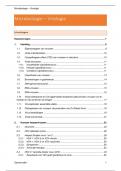Summary
Samenvatting Virologie - Microbiologie - BMW2
Course
Microbiologie (E06C3A)
Dit is een samenvatting van het deel Virologie uit het vak Microbiologie (E06C3a) gegeven door professoren Prof. P. Van den Steen en Prof. D. Schols in de richting biomedische Wetenschappen, fase 2.
[Show more]
Preview 10 out of 139 pages
Uploaded on
May 18, 2024
Number of pages
139
Written in
2023/2024
Type
Summary
Institution
Katholieke Universiteit Leuven (KU Leuven)
Education
Biomedische Wetenschappen
Course
Microbiologie (E06C3A)
All documents for this subject (59)
$6.38
100% satisfaction guarantee
Immediately available after payment
Both online and in PDF
No strings attached
Microbiologie – Virologie




